Submarine fault scarps in the Sea of Marmara pull-apart ... - HAL - IRD
Submarine fault scarps in the Sea of Marmara pull-apart ... - HAL - IRD
Submarine fault scarps in the Sea of Marmara pull-apart ... - HAL - IRD
You also want an ePaper? Increase the reach of your titles
YUMPU automatically turns print PDFs into web optimized ePapers that Google loves.
Geochemistry<br />
Geophysics<br />
Geosystems G 3<br />
G 3 armijo et al.: sea <strong>of</strong> marmara <strong>pull</strong>-<strong>apart</strong> 10.1029/2004GC000896<br />
[1] Earthquake <strong>scarps</strong> associated with recent historical events have been found on <strong>the</strong> floor <strong>of</strong> <strong>the</strong> <strong>Sea</strong> <strong>of</strong><br />
<strong>Marmara</strong>, along <strong>the</strong> North Anatolian Fault (NAF). The MARMARASCARPS cruise us<strong>in</strong>g an unmanned<br />
submersible (ROV) provides direct observations to study <strong>the</strong> f<strong>in</strong>e-scale morphology and geology <strong>of</strong> those<br />
<strong>scarps</strong>, <strong>the</strong>ir distribution, and geometry. The observations are consistent with <strong>the</strong> diversity <strong>of</strong> <strong>fault</strong><br />
mechanisms and <strong>the</strong> <strong>fault</strong> segmentation with<strong>in</strong> <strong>the</strong> north <strong>Marmara</strong> extensional step-over, between <strong>the</strong><br />
strike-slip Ganos and Izmit <strong>fault</strong>s. Smaller strike-slip segments and <strong>pull</strong>-<strong>apart</strong> bas<strong>in</strong>s alternate with<strong>in</strong> <strong>the</strong><br />
ma<strong>in</strong> step-over, commonly comb<strong>in</strong><strong>in</strong>g strike-slip and extension. Rapid sedimentation rates <strong>of</strong> 1–3 mm/yr<br />
appear to compete with normal <strong>fault</strong><strong>in</strong>g components <strong>of</strong> up to 6 mm/yr at <strong>the</strong> <strong>pull</strong>-<strong>apart</strong> marg<strong>in</strong>s. In spite <strong>of</strong><br />
<strong>the</strong> fast sedimentation rates <strong>the</strong> submar<strong>in</strong>e <strong>scarps</strong> are preserved and accumulate relief. Sets <strong>of</strong> youthful<br />
earthquake <strong>scarps</strong> extend <strong>of</strong>fshore from <strong>the</strong> Ganos and Izmit <strong>fault</strong>s on land <strong>in</strong>to <strong>the</strong> <strong>Sea</strong> <strong>of</strong> <strong>Marmara</strong>. Our<br />
observations suggest that <strong>the</strong>y correspond to <strong>the</strong> submar<strong>in</strong>e ruptures <strong>of</strong> <strong>the</strong> 1999 Izmit (Mw 7.4) and <strong>the</strong><br />
1912 Ganos (Ms 7.4) earthquakes. While <strong>the</strong> 1999 rupture ends at <strong>the</strong> immediate eastern entrance <strong>of</strong><br />
<strong>the</strong> extensional C<strong>in</strong>arcik Bas<strong>in</strong>, <strong>the</strong> 1912 rupture appears to have crossed <strong>the</strong> Ganos restra<strong>in</strong><strong>in</strong>g bend <strong>in</strong>to<br />
<strong>the</strong> <strong>Sea</strong> <strong>of</strong> <strong>Marmara</strong> floor for 60 km with a right-lateral slip <strong>of</strong> 5 m, end<strong>in</strong>g <strong>in</strong> <strong>the</strong> Central Bas<strong>in</strong> step-over.<br />
From <strong>the</strong> Gulf <strong>of</strong> Saros to <strong>Marmara</strong> <strong>the</strong> total 1912 rupture length is probably about 140 km, not 50 km as<br />
previously thought. The direct observations <strong>of</strong> submar<strong>in</strong>e <strong>scarps</strong> <strong>in</strong> <strong>Marmara</strong> are critical to def<strong>in</strong><strong>in</strong>g barriers<br />
that have arrested past earthquakes as well as def<strong>in</strong><strong>in</strong>g a possible segmentation <strong>of</strong> <strong>the</strong> contemporary state <strong>of</strong><br />
load<strong>in</strong>g. Incorporat<strong>in</strong>g <strong>the</strong> submar<strong>in</strong>e scarp evidence modifies substantially our understand<strong>in</strong>g <strong>of</strong> <strong>the</strong><br />
current state <strong>of</strong> load<strong>in</strong>g along <strong>the</strong> NAF next to Istanbul. Coulomb stress model<strong>in</strong>g shows a zone <strong>of</strong><br />
maximum load<strong>in</strong>g with at least 4–5 m <strong>of</strong> slip deficit encompass<strong>in</strong>g <strong>the</strong> strike-slip segment 70 km long<br />
between <strong>the</strong> C<strong>in</strong>arcik and Central Bas<strong>in</strong>s. That segment alone would be capable <strong>of</strong> generat<strong>in</strong>g a largemagnitude<br />
earthquake (Mw 7.2). O<strong>the</strong>r segments <strong>in</strong> <strong>Marmara</strong> appear less loaded.<br />
Components: 15,506 words, 12 figures, 1 video.<br />
Keywords: cont<strong>in</strong>ental deformation; earthquake <strong>scarps</strong>; Istanbul; <strong>Marmara</strong>; seismic hazard; submar<strong>in</strong>e morphology.<br />
Index Terms: 7223 Seismology: Earthquake <strong>in</strong>teraction, forecast<strong>in</strong>g, and prediction (1217, 1242); 7230 Seismology:<br />
Seismicity and tectonics (1207, 1217, 1240, 1242); 8110 Tectonophysics: Cont<strong>in</strong>ental tectonics: general (0905)<br />
Received 13 December 2004; Revised 2 March 2005; Accepted 24 March 2005; Published 24 June 2005.<br />
Armijo, R., et al. (2005), <strong>Submar<strong>in</strong>e</strong> <strong>fault</strong> <strong>scarps</strong> <strong>in</strong> <strong>the</strong> <strong>Sea</strong> <strong>of</strong> <strong>Marmara</strong> <strong>pull</strong>-<strong>apart</strong> (North Anatolian Fault): Implications<br />
for seismic hazard <strong>in</strong> Istanbul, Geochem. Geophys. Geosyst., 6, Q06009, doi:10.1029/2004GC000896.<br />
1. Introduction<br />
[2] The North Anatolian Fault (NAF) has almost<br />
entirely ruptured dur<strong>in</strong>g a series <strong>of</strong> large destructive<br />
earthquakes <strong>in</strong> <strong>the</strong> past century. The sequence<br />
propagated 800 km westward between 1939 and<br />
1999; an observation that has stimulated fundamental<br />
studies <strong>of</strong> <strong>fault</strong> <strong>in</strong>teraction mechanics, stress<br />
transfer and earthquake rupture processes [Toksoz<br />
et al., 1979; Ste<strong>in</strong> et al., 1997; Nalbant et al., 1998;<br />
Hubert-Ferrari et al., 2000; Parsons et al., 2000].<br />
Assessment <strong>of</strong> seismic hazard <strong>in</strong> <strong>the</strong> city <strong>of</strong> Istanbul,<br />
which is located near <strong>the</strong> western tip <strong>of</strong> <strong>the</strong><br />
propagat<strong>in</strong>g sequence, is no <strong>in</strong>dependent issue. A<br />
uniform right-lateral strike-slip motion parallel to<br />
<strong>the</strong> Anatolia/Eurasia plate boundary may have<br />
facilitated <strong>the</strong> westward progression <strong>of</strong> earthquake<br />
ruptures along most <strong>of</strong> <strong>the</strong> eastern and central NAF.<br />
However, <strong>the</strong> <strong>Sea</strong> <strong>of</strong> <strong>Marmara</strong> region located<br />
westward appears as a major transtensional stepover<br />
<strong>of</strong> <strong>the</strong> NAF dom<strong>in</strong>ated by <strong>pull</strong>-<strong>apart</strong> tectonics<br />
and slip partition<strong>in</strong>g at a range <strong>of</strong> scales [Armijo et<br />
al., 1999, 2002; Flerit et al., 2003] (Figure 1). It is<br />
thus probable that crustal scale extensional stra<strong>in</strong>s<br />
and significant normal <strong>fault</strong><strong>in</strong>g add complexity to<br />
earthquake generation <strong>in</strong> <strong>the</strong> <strong>Marmara</strong> region. The<br />
study <strong>of</strong> <strong>the</strong> geomorphology <strong>of</strong> active <strong>fault</strong>s on<br />
land appears worldwide as a good approach to<br />
unravel <strong>fault</strong> bends, slip partition<strong>in</strong>g and possible<br />
mechanical <strong>in</strong>teractions between <strong>fault</strong> segments.<br />
Methods <strong>in</strong> tectonic morphology have greatly advanced<br />
over <strong>the</strong> last 25 years aided by satellite<br />
imagery, digital topography and modern techniques<br />
for dat<strong>in</strong>g, which allow quantitative measures [e.g.,<br />
Wallace, 1981; Hanks et al., 1984; Armijo et al.,<br />
1986, 1989; Peltzer et al., 1988; Avouac et<br />
al., 1993; Wesnousky and Jones, 1994; Meyer et<br />
al., 1998; Hubert-Ferrari et al., 2002; Van der<br />
2<strong>of</strong>29




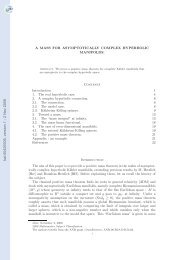
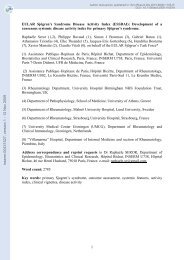
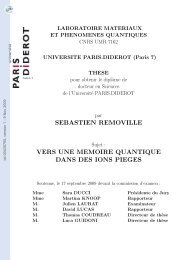
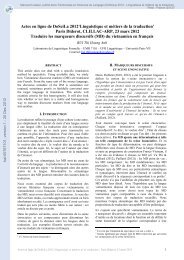
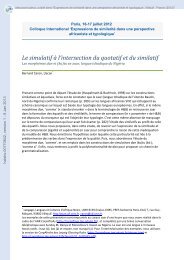
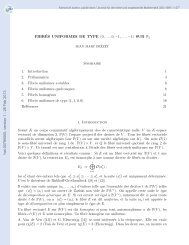
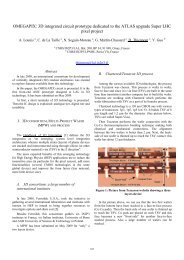
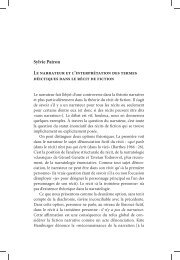
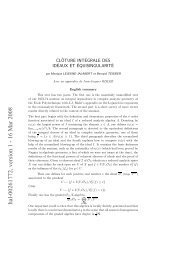
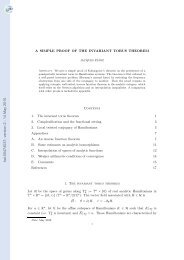

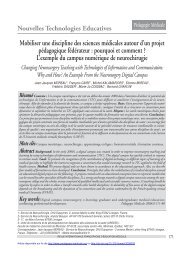

![[tel-00433556, v1] Relation entre Stress Oxydant et Homéostasie ...](https://img.yumpu.com/19233319/1/184x260/tel-00433556-v1-relation-entre-stress-oxydant-et-homeostasie-.jpg?quality=85)